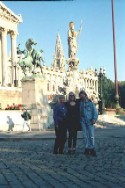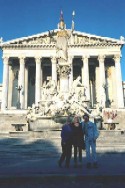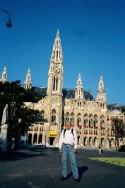The name Österreich, Austria, traces its origins
to the year 996, when the name Ostaricche first appears in literature.
Prior to that, the region was referred to as Ostmark, a name introduced
Charlemagne at the end of the 8th century A.D.
The name Wien, Vienna, can be traced
to the Romans to the year 100 A.D. as a military camp named Vindobona. Emperor Marcus Aurelius
resided and died here in 180 A.D. After the Romans withdrew in the late 4th century, the city
rapidly changed hands among the invaders (i.e. the Hungarians) who overran the region.
In the 12th century Henry Jasomirgott, first duke of Austria, transferred his residence to the town,
made it capital of the duchy. The town was fortified by the Czech King Otakar II, who conquered
Austria in 1251. In 1276, Otakar lost it again, this time to Rudolf of Habsburg
in the Battle of Marchfeld. In 1282, Vienna became the official residence of the House of Habsburg
who ruled the country until 1918.
A few significant dates:
1156 Duchy of Austria is declared
1278 The Habsburg Dynasty takes power (Rudolf von Hapsburg)
1365 University of Vienna is founded
1433 St Stephen's Cathedral is completed (work began in 1135!)
1498 Vienna Boys' Choir is founded by Emperor Maximilian I
1526 Austrian Hapsburgs inherit Bohemia and Hungary
1529 Turks besiege Vienna
1713 Schönbrunn Palace is constructed
1791 Mozart dies in Vienna
1897 Secession art movement is formed
1899 The death of Johann Strauss
1918 Austrian Empire is dismantled; end of the Hapsburg dynasty; the republic of Austria is proclaimed
1995 Austria becomes a member of the European Union
The many centuries of the Austrian monarchy are also
reflected in things more palatable than wars and invasions: food. Because the empire was widely
extended over the continent and was mixed up with multipe different nationalities and cultures (Austrians,
Czechs, Slovaks, Hungarians and others), the empire`s capital reflected the cuisine of the many cultures.
But it took Viennese chefs to adapt the foreign recipes and make them uniquely Viennese - "good plain cooking",
the way it is served in any restaurant in Vienna. Taste a Wiener Schnitzel, a tender piece of
veal cutlet wrapped in a delicate coating of bread-crumbs.
Of course, Vienna is world-renowned for
its pastries and desserts: take Kaiserschmarren (Emperor's Trifle),
the Sachertorte or a Strudel, filled with either apples or sweet cream cheese,
or Gundel-Palatschinken (stuffed crepes with chocolate and nuts), or Germknodel
(sweet dumplings with apricots or plums). The influence of the Strudel extends far
beyond Austria's borders to the Czech Republic and Germany. However, compared to that
the Sachertorte has evolved into a world-wide superpower.
Invented in 1832 in the Hotel Sacher in downtown Vienna, this dark-chocolate-and-marmelade
cake has become one of the most well-known and famous deserts in the world.
As the Sachertorte is famous, the
Wienerschnitzel has developed into a science that extends to
much greater lengths than just a simple breaded slice of meat. See for yourself:
Wiener Schnitzel - the classic, a veal cutlet, simply breaded and sautéd
Zigeunerschnitzel - any dish done Zigeuner ("gypsy") style implies a
relatively spicy sauce of tomatoes and mildly hot peppers
Naturschnitzel - an unbreaded schnitzel
Schnitzel Parisien-Art - Parisian-style, floured but not breaded
Jägerschnitzel - hunter-style, implying a sauce of mushrooms
Rahmschnitzel - with a cream sauce.
Who does this remind of the 75 shrimp recipes of Forrest Gump?
The Wienerschnitzel is closely
related to the the Italian cotoletta alla milanese,
the Czech smažený řízek (pronouced "smazhenee rzhyzek" - say that 10x times in a row...)
and Fried Breaded Pork Chops from the American South.
The Wienerschnitzel is dredged in both flour and
breadcrumbs and deepfried in lard or oil, while its Italian cousin is crusted
in flour and quickly sauteed in butter. The deep frying herritage of the Wienerschnitzel is shared by
the Czech smažený řízek as well. However, the sheer number of different ways of
deep frying breaded veal invented by Vienese chefs dwarfs everything.
The only variation
on the theme invented by Czech chefs is substituting a pork cutlet for the veal. However,
unbeknownst to most Czechs, using pork instead of veal in smažený řízek represents a
"Czech Connection" to American Soul Food most Czechs do not realize. Although the
Czechs do not eat mustard greens or sweet potato pie with their smažený řízek,
this dish is closer to Soul Food than most Czechs realize.
|
 Wien
Wien Wien
Wien






